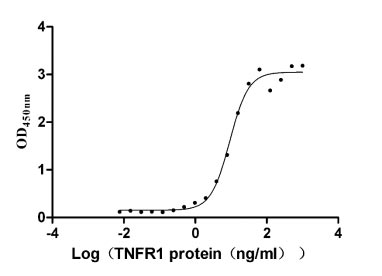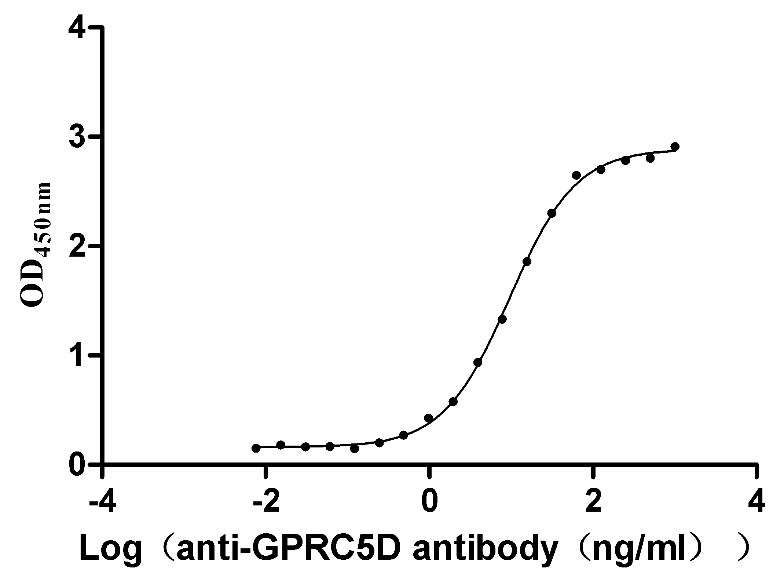Recombinant Human Killer cell immunoglobulin-like receptor 3DL1 (KIR3DL1), partial
-
货号:CSB-YP012364HU1
-
规格:
-
来源:Yeast
-
其他:
-
货号:CSB-EP012364HU1
-
规格:
-
来源:E.coli
-
其他:
-
货号:CSB-EP012364HU1-B
-
规格:
-
来源:E.coli
-
共轭:Avi-tag Biotinylated
E. coli biotin ligase (BirA) is highly specific in covalently attaching biotin to the 15 amino acid AviTag peptide. This recombinant protein was biotinylated in vivo by AviTag-BirA technology, which method is BriA catalyzes amide linkage between the biotin and the specific lysine of the AviTag.
-
其他:
-
货号:CSB-BP012364HU1
-
规格:
-
来源:Baculovirus
-
其他:
-
货号:CSB-MP012364HU1
-
规格:
-
来源:Mammalian cell
-
其他:
产品详情
-
纯度:>85% (SDS-PAGE)
-
基因名:
-
Uniprot No.:
-
别名:KIR3DL1; CD158E; NKAT3; NKB1; Killer cell immunoglobulin-like receptor 3DL1; CD158 antigen-like family member E; HLA-BW4-specific inhibitory NK cell receptor; MHC class I NK cell receptor; Natural killer-associated transcript 3; NKAT-3; p70 natural killer cell receptor clones CL-2/CL-11; p70 NK receptor CL-2/CL-11; CD antigen CD158e
-
种属:Homo sapiens (Human)
-
蛋白长度:Partial
-
蛋白标签:Tag type will be determined during the manufacturing process.
The tag type will be determined during production process. If you have specified tag type, please tell us and we will develop the specified tag preferentially. -
产品提供形式:Lyophilized powder
Note: We will preferentially ship the format that we have in stock, however, if you have any special requirement for the format, please remark your requirement when placing the order, we will prepare according to your demand. -
复溶:We recommend that this vial be briefly centrifuged prior to opening to bring the contents to the bottom. Please reconstitute protein in deionized sterile water to a concentration of 0.1-1.0 mg/mL.We recommend to add 5-50% of glycerol (final concentration) and aliquot for long-term storage at -20℃/-80℃. Our default final concentration of glycerol is 50%. Customers could use it as reference.
-
储存条件:Store at -20°C/-80°C upon receipt, aliquoting is necessary for mutiple use. Avoid repeated freeze-thaw cycles.
-
保质期:The shelf life is related to many factors, storage state, buffer ingredients, storage temperature and the stability of the protein itself.
Generally, the shelf life of liquid form is 6 months at -20°C/-80°C. The shelf life of lyophilized form is 12 months at -20°C/-80°C. -
货期:Delivery time may differ from different purchasing way or location, please kindly consult your local distributors for specific delivery time.Note: All of our proteins are default shipped with normal blue ice packs, if you request to ship with dry ice, please communicate with us in advance and extra fees will be charged.
-
注意事项:Repeated freezing and thawing is not recommended. Store working aliquots at 4°C for up to one week.
-
Datasheet :Please contact us to get it.
相关产品
靶点详情
-
功能:Receptor on natural killer (NK) cells for HLA Bw4 allele. Inhibits the activity of NK cells thus preventing cell lysis.
-
基因功能参考文献:
- human leukocyte antigen (HLA)-Bw4 is associated with susceptibility to psoriatic disease (PsD), but genetic interactions with their cognate ligand, variably expressed killer cell immunoglobulin like receptor (KIR) 3DL1 alleles PMID: 28801811
- HLA-Bw4-80(T) and multiple HLA-Bw4 copies in combination with KIR3DL1 are associated with protection against chronic hepatitis C in people who inject drugs by distinct mechanisms. PMID: 28412292
- Higher proportion of NK cells expressing inhibitory CD158b and CD158e receptors is associated with significant liver injury in children with chronic hepatitis C. PMID: 28611271
- KIR3DL1*0010101 and low mRNA expression is associated with antibody mediated acute rejection and chronic rejection. PMID: 28942035
- This study suggests a possible role of killer cell immunoglobulin-like receptors and their ligands in the development of liver damage. The absence of human leucocyte antigen C1 and C2 ligands heterozygosity could lead to less inhibition of natural killer cells and a quicker progression to a high level of fibrosis in patients infected with hepatitis C virus, especially following liver transplantation. PMID: 26717049
- KIR loci in terms of copy number and haplotypes are not likely to play a major role in antibody response to measles vaccination. PMID: 28158231
- Among 11 discovered KIR genotypes, 6 genotypes showed a considerable role and 4 genotypes could preclude the risk of systemic sclerosis (SSc) disease. significant confounding effects were seen between involved genes in these two combinations: "KIR3DL1; HLA-BW4-Thr80" and "KIR3DL1 -HLA-BW4-A1." PMID: 28120169
- The present study for the first time presents the beneficial effects of KIR genotype matching in reducing cGVHD in myeloablative transplant setting using HLA matched (sibling and unrelated) donors. The findings offer a clinically applicable donor selection strategy that can help control cGVHD without affecting the risk of relapse and/or identify patients at a high risk of developing cGVHD PMID: 27341514
- the KIR3DL1*001, *005, and *015 polymorphisms are remote from the KIR3DL1-HLA-I interface, the structures of these three KIR3DL1-HLA-I complexes showed that the broader HLA-I specificity of KIR3DL1*005 correlated with an altered KIR3DL1*005 interdomain positioning and increased mobility within its ligand-binding site. PMID: 27045007
- evidence that KIR-regulated signaling contributes to Behcet's disease PMID: 27708262
- KIR3DL1 in combination with HLA-A and -B alleles bearing the Bw4 motif show strong protective effect against multiple sclerosis in African Americans. PMID: 26866467
- s results suggest that low cell-surface expression of KIR3DL1 in the presence of the HLA-Bw4 epitope is associated with an increased risk for developing psoriasis. PMID: 26286807
- Using depletion studies and Killer immunoglobulin-like receptors-transfected cell lines, demonstrated that the dengue virus NS1 tetramer bound the inhibitory receptor KIR3DL1. PMID: 26439909
- KIR3DL1 interaction with HLA-B27 is altered by ankylosing spondylitis associated ERAP1 and enhanced by MHC class I cross-linking PMID: 26321090
- In early axial spondyloarthritis and ankylosing spondylitis Dutch patients, no copy number changes were found for KIR3DL1. PMID: 25940819
- KIR3DL1 has a protective effect against the more severe manifestations of ankylosing spondylitis. PMID: 26238044
- Individuals who carried both KIR3DS1 and Bw4*80I did not remain HIV seronegative longer than those from a control group who were homozygous for HLA-Bw6 and carried no HLA-A locus Bw4 alleles PMID: 25330014
- Protective genotypes in HIV infection reflect superior function of KIR3DS1 over KIR3DL1-expressing CD8+ T cells. PMID: 25112829
- KIR3DL1-HLA-Bw4 combination and IL28B polymorphism predict response to Peg-IFN and ribavirin with and without telaprevir in chronic hepatitis C patients. PMID: 24929144
- the strict conformation of HLA-Bw4 allotypes, held in place by the Glu(76)-Arg(83) interaction, facilitates KIR3DL1 binding, whereas Bw6 allotypes present a platform on the alpha1 helix that is less permissive for KIR3DL1 binding. PMID: 25480565
- HIV protective KIR3DL1/S1-HLA-B genotypes influence NK cell-mediated inhibition of HIV replication in autologous CD4 targets. PMID: 24453969
- The frequency of KIR3DL1 with HLA-Bw4 was significantly lower in diffuse large B-cell lymphoma patients than in controls. PMID: 24755352
- Characterizing Maori and Polynesians is a paucity of HLA-B allotypes recognized by KIR. PMID: 25139336
- KIR3DL1 genetic diversity in the Chinese Han population and it's mRNA expression pattern PMID: 24173144
- Different KIR3DS1, KIR3DL1 and HLA-Bw4 genotypes and levels of transcripts associate with HIV disease progression. PMID: 24059286
- Data indicate the impact of KIR3DL1 polymorphism on peptide-laden HLA recognition. PMID: 24563253
- The results of this study found that specific combinations of KIR and their HLA ligands can be either risk factors or protective for immune responses triggering Guillain-Barre Syndrome. PMID: 24367901
- HLA-B alleles carrying Bw4 epitope present the highest capability of interaction with KIR3DL1 *001 compared to the HLA-B alleles presenting Bw6. PMID: 23984333
- present work has shown that IL-2 and IL-15, cytokines critical for NK cell development and maintenance, greatly stimulate KIR3DL1 reverse promoter activity, but not forward promoter activity PMID: 23328843
- Both the nature of KIR3DL1 alleles and the KIR3DL1/S1 allele combination affect the KIR3DL1 NK-cell repertoire in the French population. PMID: 23436464
- Report reliable and accurate method for genotyping KIR3DL1/S1 using DNA recovered from plasma. PMID: 23524032
- Our data suggest a possible association of KIR/HLA variants and the severity of Gaucher disease. PMID: 23266622
- Increased matching between expressed KIR-3DL1 and its ligand HLA-Bw4 was found in Italian patients with paroxysmal nocturnal haemoglobinuria. PMID: 22803950
- results show that immunogenetic factors, such as the KIR gene profile, can play a role in tyrosine kinase inhibitor therapy response PMID: 22842045
- structure of a human KIR3DL1 receptor bound to HLA-B*5701 complexed with a self-peptide PMID: 22020283
- the pattern of inhibitory/activating KIR genes, together with their HLA ligands, is associated with susceptibility to B-cell chronic lymphocytic leukemia and affects the clinical course of this disease PMID: 21726204
- KIR3DL1 gene expression is upregulated in intestinal mucosa in active celiac disease. PMID: 21616111
- The first Ig domain of KIR3DL1 contacts MHC class I at a secondary site. PMID: 21746965
- In this review, KIR3DL1/S1 is described as the most extensively studied of the variable natural killer (NK) cell receptors, exemplifying how variation in all possible parameters of function is recruited to diversify the human NK cell response. PMID: 21690332
- The less the KIR/HLA-Cw matched, the more cytotoxic activity was shown in NK cells. PMID: 19549379
- Enhanced NK polyfunctionality in HIV slow progressors was dependent upon the coexpression of both KIR3DL1*h/*y and HLA-B*57. PMID: 21471235
- Distinct HIV-1 epitopes differentially modulated the binding of KIR3DL1 to HLA-Bw4. PMID: 21471246
- It was observed that the Thai population shows polymorphism of the KIR genes and the diversities of KIR genes in Thai differed from other populations. PMID: 21696085
- analysis of evolution in the centromeric and telomeric regions of group A and B haplotypes of the human killer cell Ig-like receptor locus PMID: 21206914
- genetic polymorphism contributes to pathogenesis of ankylosing spondylitis PMID: 20652381
- This finding indicates that the inhibitory KIR3DL1 receptor protects against the development of ankylosing spondylitis and is not simply a passive counterpart of the segregating KIR3DS1 allele encoding the activating receptor. PMID: 20818412
- expression levels of KIR3DL1 may be involved in the pathogenesis of ankylosing spondylitis PMID: 20574122
- Natural killer (NK) cell receptor KIR3DL1*004 is sequestered in the endoplasmic reticulum of the NK cell where it binds to the chaperone calreticulin and does not induce the unfolded protein response. PMID: 21115737
- Results indicate a prominent role for KIR3DL1/HLA-Bw4 interactions in licensing natural killer cells for CD16-mediated effector function. PMID: 20664023
- KIR3DL1 and KIR3DS1 allele frequencies were determined by DNA sequencing of the complete coding regions from 100 random unrelated African Americans PMID: 20230527
显示更多
收起更多
-
亚细胞定位:Cell membrane; Single-pass type I membrane protein.
-
蛋白家族:Immunoglobulin superfamily
-
数据库链接:
HGNC: 6338
OMIM: 604946
KEGG: hsa:3811
STRING: 9606.ENSP00000375608
UniGene: Hs.645228
Most popular with customers
-
Recombinant Human Tumor necrosis factor receptor superfamily member 1A (TNFRSF1A), partial (Active)
Express system: Mammalian cell
Species: Homo sapiens (Human)
-
Recombinant Human G-protein coupled receptor family C group 5 member D (GPRC5D)-VLPs (Active)
Express system: Mammalian cell
Species: Homo sapiens (Human)
-
Recombinant Mouse Retinol-binding protein 4 (Rbp4) (Active)
Express system: Mammalian cell
Species: Mus musculus (Mouse)
-
Recombinant Human Somatostatin receptor type 2 (SSTR2)-VLPs (Active)
Express system: Mammalian cell
Species: Homo sapiens (Human)
-
Recombinant Macaca fascicularis Claudin (CLDN18)-VLPs (Active)
Express system: Mammalian cell
Species: Macaca fascicularis (Crab-eating macaque) (Cynomolgus monkey)
-
Recombinant Macaca fascicularis CD93 molecule (CD93), partial (Active)
Express system: Mammalian cell
Species: Macaca fascicularis (Crab-eating macaque) (Cynomolgus monkey)
-
Recombinant Macaca fascicularis lymphocyte antigen 6 family member G6D (LY6G6D) (Active)
Express system: Yeast
Species: Macaca fascicularis (Crab-eating macaque) (Cynomolgus monkey)
-
Recombinant Rat Gastric inhibitory polypeptide receptor (Gipr), partial (Active)
Express system: Mammalian cell
Species: Rattus norvegicus (Rat)




















